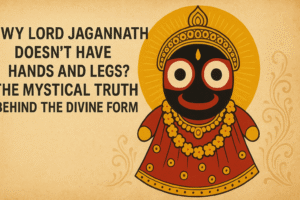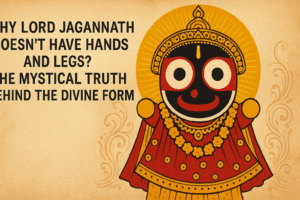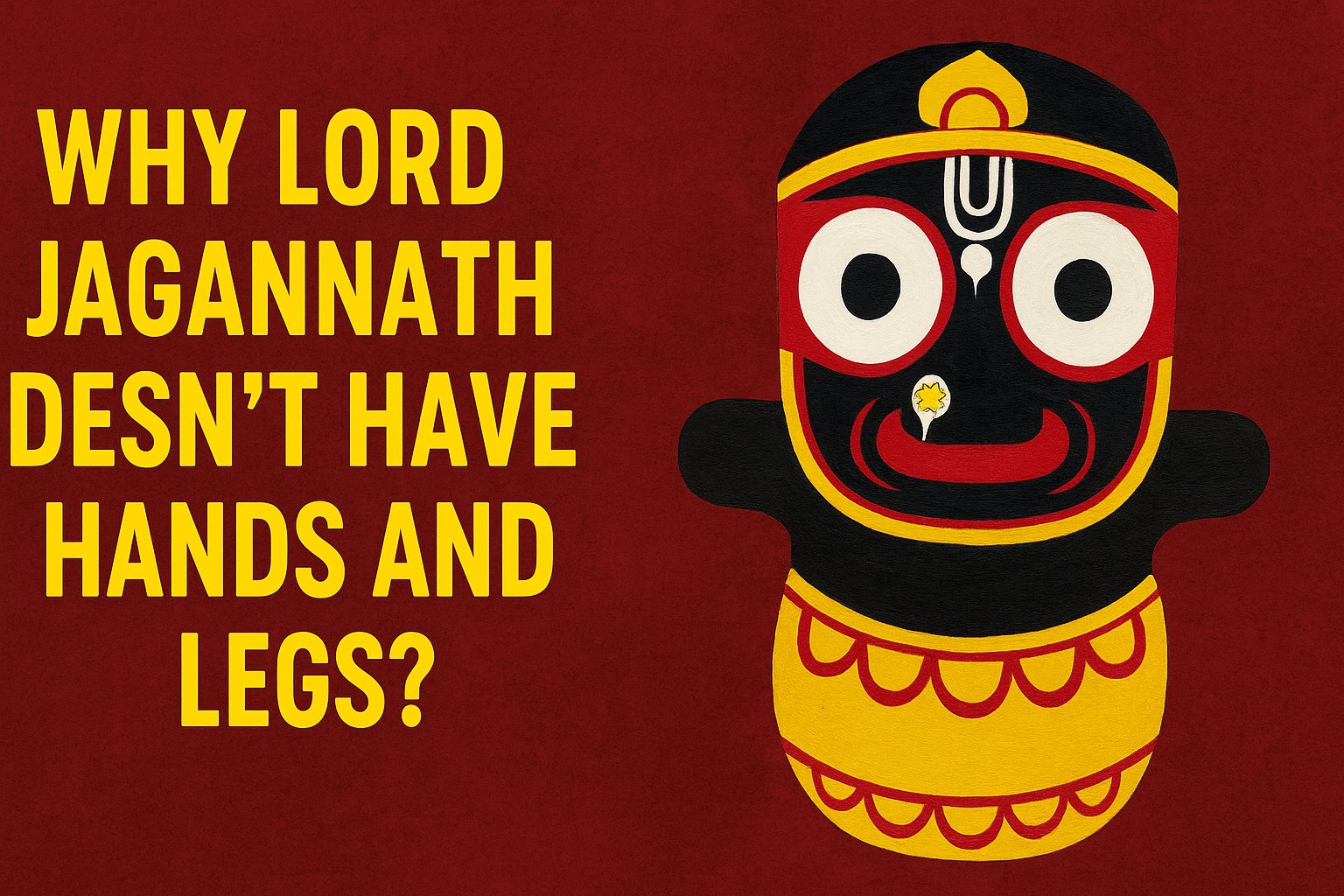
Why Lord Jagannath Doesn’t Have Hands and Legs?
Lord Jagannath, the presiding deity of the sacred Jagannath Temple in Puri, Odisha, is revered as a form of Lord Vishnu, and more specifically, Lord Krishna. What sets the idol of Jagannath apart from all other deities in Hinduism is His unique form — without hands and legs. Devotees across the world bow before this divine wooden idol, yet often wonder: Why does Lord Jagannath not have hands and legs?
In this article, we delve into the spiritual, mythological, and symbolic meanings behind this mysterious and deeply revered form of Lord Jagannath.
✨ The Divine Incomplete Form – A Story of Eternal Love
The most popular legend associated with the form of Lord Jagannath is the story of King Indradyumna, a devout ruler and an ardent devotee of Lord Vishnu.
According to Skanda Purana, the king once had a divine vision of Lord Vishnu’s Neela Madhava form. Driven by devotion, he searched for this divine form and was eventually guided to carve idols of Jagannath, Balabhadra, and Subhadra from a sacred neem tree.
🔱 The Mysterious Carpenter and the Condition
As per legend, Lord Vishwakarma (or sometimes referred to as an old carpenter sage) appeared in disguise and offered to carve the idols. But there was a divine condition:
“No one should open the doors of the workshop for 21 days.”
Curious and impatient, the king opened the door prematurely. The idols were incomplete — Lord Jagannath without hands and feet. Yet, a divine voice declared:
“This is the form I chose to manifest in. I shall reside here and be worshipped in this very form for the upliftment of devotees in Kali Yuga.”
Table of Contents
🕉️ The Spiritual Symbolism: Beyond Physical Form
The form of Lord Jagannath carries deep spiritual significance:
Universal Acceptance: Jagannath’s incomplete form symbolizes that God is beyond physical form. He is not limited to human features — His essence is formless, eternal, and accessible to all.
Open Arms of Compassion: Though His arms are not visible, it is believed that Jagannath has eternal open arms, always ready to embrace His devotees with unconditional love and grace.
Transcending Ego: His unfinished form teaches us to rise beyond the ego of perfection and understand the beauty of spiritual imperfection.

📜 Philosophical Meaning in Sanatan Dharma
In Vedantic thought, God is often described as:
“Nirguna (without attributes), Nirakara (without form), yet can manifest in Saguna-Sakara (with attributes and form) for the sake of devotees.”
Jagannath’s form represents this profound paradox — He is the Supreme Brahman, choosing to appear incomplete in form to teach us humility, detachment, and surrender.
🏹 Krishna’s Mahabharata Connection
Some believe that the form of Jagannath resembles Lord Krishna’s final moments on Earth, when He left His mortal body in the forest after being hit by a hunter’s arrow. His body was found in an unrecognizable state — similar to the rounded form of Jagannath — symbolizing the end of Krishna’s physical avatar but not His divine presence.
🌍 A Global Message of Unity
Lord Jagannath is worshipped not only in India but across the world — His annual Rath Yatra attracts millions of devotees. His form, beyond caste, color, or completeness, sends a universal message:
“God doesn’t look at your body — He looks at your bhakti (devotion).”
🔚 Conclusion: A Form That Touches the Soul
The form of Lord Jagannath without hands and legs is not a flaw, but a divine mystery, wrapped in stories, symbolism, and deep philosophy. It teaches us that divinity lies not in perfection of form, but in the purity of heart.
So when you stand before Lord Jagannath, remember — His incomplete form completes your faith.

📌 More Frequently Asked Questions (FAQs)
Q1: Is the form of Jagannath intentional or incomplete due to mistake?
➤ It is intentional and considered divine by scriptures and devotees alike.
Q2: Why is the idol made of wood, not stone?
➤ It is made from sacred Neem (Daru) wood as per divine instructions and replaced every 12–19 years in a secret ritual called Nabakalebara.
Q3: What do devotees feel when they see Jagannath’s form?
➤ Peace, surrender, and a sense of being embraced by the formless, limitless divine.
Q4: What is the meaning of the name ‘Jagannath’?
➤ Jagannath means “Lord of the Universe” (Jagat = Universe, Nath = Lord). He is believed to be the supreme form of Vishnu/Krishna who governs the cosmos.
Q5: Why does Lord Jagannath appear with Subhadra and Balabhadra?
➤ The trio represents the divine siblings — Balabhadra (Balaram), Subhadra, and Jagannath (Krishna). Their appearance together symbolizes unity, family love, and balance in creation.
Q6: Why are the eyes of Lord Jagannath so big and round?
➤ His large, round eyes represent His all-seeing nature. Without eyelids, they signify eternal awareness, that He is always watching and protecting His devotees.
Q7: Why is Jagannath worshipped in a wooden form?
➤ Unlike most deities in Hindu temples who are made of stone or metal, Lord Jagannath is made from sacred Neem wood, which is selected through divine rituals. This reflects the living, breathing presence of the Lord.
Q8: What happens to the old idols during Nabakalebara?
➤ During Nabakalebara, the old idols are ceremonially buried in the temple’s Koili Baikuntha (a sacred ground inside the temple), and new ones are installed with the transfer of Brahma Padartha (divine life essence).
Q9: Can devotees touch the idol of Lord Jagannath?
➤ No, only designated priests (sevayats) are allowed to touch the idol. However, devotees can have darshan (sacred viewing) and participate in rituals, especially during the famous Rath Yatra.
Q10: Is there any scientific explanation for the form of Lord Jagannath?
➤ Some scholars believe that the form represents ancient tribal or folk art styles, but for devotees, it remains a spiritual manifestation beyond science — a symbol of cosmic divinity beyond human understanding.
🧾 Summary: Why Lord Jagannath Doesn’t Have Hands and Legs
Lord Jagannath, the divine form of Lord Krishna worshipped in Puri, appears without hands and legs — a form that is spiritually significant and deeply symbolic. According to legend, King Indradyumna interrupted the divine carving process by opening the door early, resulting in the idol’s incomplete form. But Lord Jagannath declared this as His chosen manifestation for the Kali Yuga.
This form teaches us that God is beyond physical attributes, representing universal love, inclusiveness, and eternal awareness. His large, round eyes watch over all, and His open, invisible arms embrace every soul.
Worshipped along with His siblings Balabhadra and Subhadra, and made of sacred neem wood, Lord Jagannath’s unique form continues to inspire devotion, mystery, and divine connection for millions across the globe.
Let me know if you’d like this summary converted into a voiceover script, reel/shorts caption, or translated into Hindi for your audience.
Let me know if you’d like to turn this into a visually engaging blog layout, or if you want Hindi translation, social media post, or a YouTube Shorts script based on this article!
Unlock the Ancient Wisdom of Sanatan Dharma – Join Us on YouTube!
👉 Subscribe now to Prachin Sanatan Dharma and embark on a journey of enlightenment.
Explore timeless teachings, spiritual insights, and cultural richness on our YouTube channel, Prachin Sanatan Dharma. Dive deep into the essence of Sanatan Dharma through captivating videos that inspire and educate.
Related Articles
- Restful Nights: Ayurvedic Remedies and Traditional Indian Practices to Overcome Insomnia and Late-Night Habits
- The Tridevi: Lakshmi, Saraswati, and Parvati – Their Roles and Powers
- “Divine Creatures of Ancient Indian Scriptures: Exploring the Role of Animals in the Vedas, Puranas, and Mahabharata”
- Nature and Spirituality: Exploring the Sacred Essence of the Himalayas, Ganga, and Other Natural Wonders”
- “Reviving the Gurukul System: Relevance and Lessons for Modern Education”
- “Exploring Greek and Indian Mythology: Similarities Between Greek and Indian Mythology “
- “Embracing Sattvic Living: Harmonizing Mind, Body, and Soul Through Food and Lifestyle”
- “Charity and Prosperity: Exploring the Concept of Daan and Its Financial Relevance in Modern Life”
- How to Build an Eco-Friendly Home Inspired by Vastu Shastra
- Comparison of Ancient and Modern Sports: How Traditional Sports Have Influenced Contemporary Games
- “Timeless Lessons from Ancient Tales: Linking Samudra Manthan and Ganga’s Descent to Modern Ecological Challenges”
- “Reviving Sanskrit: How AI is Preserving Ancient Languages for the Future”
- “Mathura: The Sacred Land of Lord Krishna’s Divine Leelas”
- Investing for Future Generations: Lessons from Indian Traditions on Legacy Building and Wealth Preservation
- “Ancient Indian Wisdom: Timeless Lessons for Tackling Today’s Climate Crisis”
- “Artificial Intelligence and Spirituality: Transforming Ancient Practices for the Modern World”
- “Gold and Real Estate in India: Timeless Assets Shaping Financial Strategies”
- Tradition Meets Innovation: The Evolution of Technology in Hindu Rituals
- End-of-World Myths: Exploring Kali Yuga in Hinduism and Ragnarök in Norse Mythology
- Garuda, Pegasus, and Dragons: The Universal Ties of Mythical Beasts Across Cultures
- “Ancient Vimanas: Mythical Flying Machines or Evidence of Advanced Technology?”
- Time Travel in Hindu Mythology: The Fascinating Tales of Kakudmi and King Raivata
- “Divine Feminine Power in Hindu Mythology: The Legends of Durga, Saraswati, and Lakshmi”
- “Divine Beings of Sanatan Dharma: The Spiritual Significance of Sacred Animals in Hinduism”
- “Symbolism in Mythological Art: Unlocking Hidden Meanings in Ancient Temple Carvings”
- “Exploring Technological Advancements in Ancient India and Civilizations: Vimana, Metallurgy, & Water Management systems”
- Unveiling the Mysteries: Ancient Temples of Sanatan Dharma , Mysterious Temples of India
- “The Scientific Knowledge of Sanatan Dharma: Ancient Wisdom Meets Modern Science”
- Ancient Indian Sports and Games: Celebrating a Legacy of Skill, Strength & Strategy”
- “Exploring the Cosmic Link: The Connection Between Astronomy and Vedic Astrology”
- The Power of Sanskrit: Unlocking the Divine Language of the Gods
- “The End of Kaliyuga: A Sanatan Insight into the World’s Final Chapter”
- Explore more articles on Prachin Sanatan Yuga.
Why Lord Jagannath Doesn’t Have Hands and Legs? The Mystical Truth Behind the Divine Form Why Lord Jagannath Doesn’t Have Hands and Legs? The Mystical Truth Behind the Divine Form Why Lord Jagannath Doesn’t Have Hands and Legs? The Mystical Truth Behind the Divine Form Why Lord Jagannath Doesn’t Have Hands and Legs? The Mystical Truth Behind the Divine Form
Why Lord Jagannath Doesn’t Have Hands and Legs? The Mystical Truth Behind the Divine Form Why Lord Jagannath Doesn’t Have Hands and Legs? The Mystical Truth Behind the Divine Form Why Lord Jagannath Doesn’t Have Hands and Legs? The Mystical Truth Behind the Divine Form Why Lord Jagannath Doesn’t Have Hands and Legs? The Mystical Truth Behind the Divine Form
Why Lord Jagannath Doesn’t Have Hands and Legs? The Mystical Truth Behind the Divine Form Why Lord Jagannath Doesn’t Have Hands and Legs? The Mystical Truth Behind the Divine Form Why Lord Jagannath Doesn’t Have Hands and Legs? The Mystical Truth Behind the Divine Form Why Lord Jagannath Doesn’t Have Hands and Legs? The Mystical Truth Behind the Divine Form
Why Lord Jagannath Doesn’t Have Hands and Legs? The Mystical Truth Behind the Divine Form Why Lord Jagannath Doesn’t Have Hands and Legs? The Mystical Truth Behind the Divine Form Why Lord Jagannath Doesn’t Have Hands and Legs? The Mystical Truth Behind the Divine Form Why Lord Jagannath Doesn’t Have Hands and Legs? The Mystical Truth Behind the Divine Form
Why Lord Jagannath Doesn’t Have Hands and Legs? The Mystical Truth Behind the Divine Form Why Lord Jagannath Doesn’t Have Hands and Legs? The Mystical Truth Behind the Divine Form Why Lord Jagannath Doesn’t Have Hands and Legs? The Mystical Truth Behind the Divine Form Why Lord Jagannath Doesn’t Have Hands and Legs? The Mystical Truth Behind the Divine Form
Why Lord Jagannath Doesn’t Have Hands and Legs? The Mystical Truth Behind the Divine Form Why Lord Jagannath Doesn’t Have Hands and Legs? The Mystical Truth Behind the Divine Form Why Lord Jagannath Doesn’t Have Hands and Legs? The Mystical Truth Behind the Divine Form Why Lord Jagannath Doesn’t Have Hands and Legs? The Mystical Truth Behind the Divine Form
